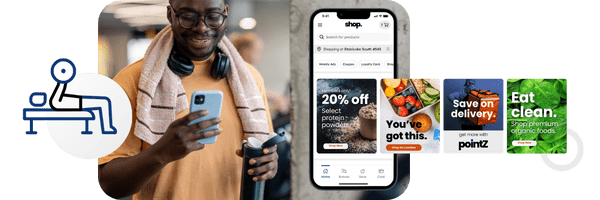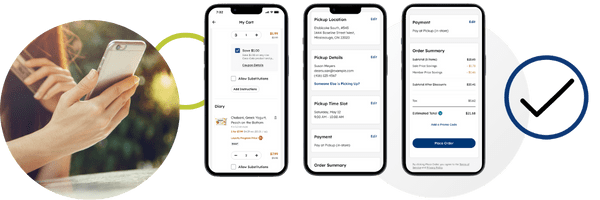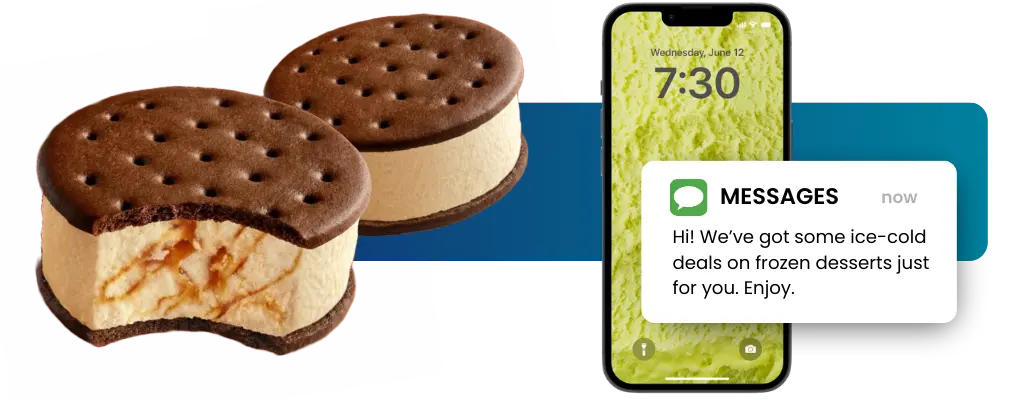
Why Your Grocery eCommerce Website Needs These Four Features
This article was originally published with the title “Your Grocery eCommerce Website Needs These 4 Features” on January 14, 2022. It was updated on January 27, 2025.
When you engage your customer, you retain your customer.
This is what it all boils down to for grocers offering online grocery shopping.
Every month, we see the data from the Brick Meets Click/Mercatus Grocery Shopper Survey, and the message is clear: enhancing the customer experience is critical to retaining your customers.
In today’s grocery market, the required focus on customer engagement begins with an eCommerce website. Why is the frontline of a grocer’s online store so important?
Online Grocery Sales Are Growing
In 2024, we saw tremendous year-over-year growth in eGrocery, driven in large part by big players offering deep discounts on annual membership plans that include reduced fees for online grocery delivery services.
Even before these initiatives gained traction, total eGrocery sales were already projected to reach a staggering $120 billion annually by the end of 2028. According to the 2024 Brick Meets Click U.S. eGrocery 5-Year Sales Forecast, this growth will be three times faster than in-store sales.
The takeaway? Retailers need to focus on their grocery eCommerce platform to engage and retain their customers.
But it’s not enough to just have a website for an online grocery store. To get the type of customer engagement that leads to customer retention, the experience must be seamless, engaging, and built with the customer in mind.
In this article, we’ll explore four essential features that every grocery eCommerce platform must have to succeed in today’s online grocery industry. These are the foundation of creating an online grocery shopping experience that drives engagement, boosts loyalty, and keeps your customers coming back.
1. Provide a Personalized Experience with Your eCommerce Platform
Personalization is at the heart of these essential features, offering the most direct path to creating the kind of engaging, loyalty-building experiences that define a successful grocery eCommerce platform.

The entire retail sector has long recognized the potential of personalization—where every customer interaction feels tailored to their needs, preferences, and habits. For grocers, this vision has always been particularly appealing, yet difficult to achieve at scale.
Now, with the advanced technological capabilities of modern grocery eCommerce solutions, that vision is becoming a reality. With the ability to collect and consolidate customer data, grocers can now unlock deeper insights into shopper behavior. Advances in AI and machine learning take this further, enabling the delivery of personalized offers, reminders, and recommendations.
These technologies allow grocers to connect with customers in ways that were once unimaginable, fostering deeper relationships and driving repeat business.
Engaging the Customer with an Outstanding Shopping Experience
This is important because modern consumers expect more than just competitive pricing; they demand a shopping experience that caters to their unique needs.
We see this clearly in the findings of the US eGrocery Shopper Profiles Report with Brick Meets Click, which addresses the need for grocers to:
- Strengthen personalization efforts by using data to deliver tailored offers and seamless experiences to all customer segments.
- Own customer relationships by taking greater control of the shopping experience.
- Evaluate value propositions to focus on what sets grocers apart, such as high levels of customer service.
For grocers, addressing these challenges means leveraging technology to offer tailored product recommendations, discounts based on past purchases, and reminders timed to purchase cycles.
These targeted touches create a more relevant shopping journey that keeps customers engaged in a longer-term relationship with a grocery retailer.
Bringing High-touch Service to the Digital Experience
Personalization also aligns perfectly with what has long been a unique selling point for grocers: high-touch, in-store customer service.
In brick-and-mortar stores, grocers have built their reputations on attentive, personalized service—knowing regular customers’ preferences, recommending new products, and ensuring a smooth, welcoming shopping experience.
By bringing this same high-touch philosophy to the digital world, grocers can differentiate themselves in ways that larger retailers struggle to match. While mass merchants may offer lower prices, their one-size-fits-all approach often lacks the personal connection customers value.
Regional grocers and independents, on the other hand, can use personalization to replicate their in-store strengths—tailored recommendations, meaningful promotions, and proactive service—across their eCommerce platform.
This high-touch online grocery shopping experience not only drives immediate engagement but also inspires customers to return.
2. Give Consumers a Seamless Online Grocery Shopping Experience
Personalization may set your grocery eCommerce platform apart, but it’s the basics—like smooth navigation, easy checkout, and flexible payment options—that lay the foundation for a successful, frustration-free customer experience.

If these core elements are lacking, even the best personalization tools won’t keep customers from abandoning their carts.
Here are the essential building blocks for a friction-free online experience:
Streamline the Checkout Process: A complicated or lengthy checkout is one of the top reasons shoppers abandon their carts. Simplify the process with features like a single-page checkout, guest checkout options, and clear, upfront grocery delivery or pickup details.
Offer Multiple Payment Options: Shoppers expect flexibility when it comes to payment. Beyond credit and debit cards, consider including options from digital wallets like Apple Pay or Google Pay. Flexible payment solutions make the process smoother and more inclusive.
Ensure Real-time Inventory Visibility: Few things frustrate shoppers more than selecting products only to find out they’re out of stock at checkout. Accurate, up-to-date inventory visibility is key to building trust and minimizing friction.
Optimize for Mobile: With so many customers shopping from their phones, a fully responsive mobile site or grocery app is non-negotiable. Make sure navigation, search, and checkout work seamlessly across all devices.
Simplify Product Search and Discovery: A strong search function helps shoppers find what they need quickly. Features like autocomplete, category filters, and dietary preference tags (e.g., “gluten-free” or “organic”) enhance discoverability and improve the user experience.
These foundational elements ensure your grocery eCommerce platform delivers an intuitive, frustration-free experience.
Providing a Streamlined Omnichannel Experience
While the focus of this discussion has been on grocery eCommerce websites, it’s important to recognize that today’s customers don’t shop exclusively through a single channel. Instead, they expect a seamless experience across online, mobile, and in-store interactions.
For some shoppers, the online grocery store serves as the first touchpoint—a place to check product availability, browse promotions, and plan purchases before heading to a physical store. If the experience feels disjointed or incomplete at any stage, grocers risk losing engagement and, ultimately, customer loyalty.
This makes the level of personalization we already discussed the key driver of a cohesive omnichannel experience.
When personalization is effectively implemented, it bridges the gap between online and offline channels. Shoppers can transition effortlessly from receiving tailored recommendations online to completing purchases in-store, or vice versa.
Grocers who unify customer data and use it to personalize every step of the journey can create a truly connected experience that builds trust and loyalty. Here’s how to do that:
- Unify Customer Data: Integrate data from all touchpoints—online, mobile, and in-store—to create a single, comprehensive view of each customer. This enables timely, relevant recommendations that reflect individual preferences and behaviors.
- Personalize Every Step: Deliver tailored offers and promotions across platforms, from personalized email campaigns to mobile app notifications, reinforcing the connection between the grocer and the customer.
- Offer Seamless Fulfillment Options: Combine online and offline convenience through features like in-store pickup, same-day grocery delivery, and real-time inventory visibility, ensuring customers can shop in a way that suits their needs.
3. Enhance Fulfillment Options for a Successful Online Store
Fulfillment isn’t just an element of omnichannel shopping. It’s where the online grocery experience comes to life, bridging the gap between digital convenience and in-person service to meet customers’ expectations for speed, accuracy, and flexibility.
Offering flexibility in fulfillment options is critical for meeting the diverse needs of today’s grocery shoppers. Some customers prioritize cost-saving options like in-store pickup, while others value time-saving methods such as same-day grocery delivery services.
For regional grocers and independents, success lies in optimizing the fulfillment services that align best with their strengths—particularly in-store pickup.
Even with the reduced delivery fees that are currently driving eGrocery sales in that specific segment, pickup remains the most popular online grocery fulfillment method, offering both convenience for customers and operational efficiency for grocers.
By improving the speed, accuracy, and personalization of their pickup services, grocers can deliver a fulfillment experience that keeps customers satisfied while reducing costs.
Practical Strategies to Optimize Fulfillment
Here are three proven strategies grocers can implement to enhance their existing fulfillment services without stretching resources thin:
Define and Measure Operational Performance
Establish clear, measurable expectations for your fulfillment operations. Develop a company-wide scorecard that tracks key performance indicators (KPIs) such as:
- On-time orders
- Units picked per hour (UPH)
- Out-of-stock (OOS) percentages
- Substitution rates
- Labor utilization
- Perfect order rates (on-time and accurate fulfillment)
Share these metrics with store teams weekly and align goals across operations to ensure everyone is working toward improving fulfillment speed and accuracy.
Optimize In-store Picking Efficiency
Small changes to operations can have a big impact on profitability.
Reduce the time spent navigating the grocery store by implementing optimized routes or mapping tools for eGrocery pickers. When you train staff to follow efficient pathways, you’ll minimize unnecessary steps, ensuring faster order completion and lower labor costs.
An organized approach to routing improves productivity and enhances the customer experience through quicker order turnaround times.
Leverage Multi-order and Zone-picking
You can also increase fulfillment capacity by allowing pickers to handle multiple orders simultaneously.
With multi-order picking, staff can fulfill several orders in a single trip, reducing time spent backtracking through the aisles. To optimize this process, introduce zone-picking methods, where staff focus on specific store areas to streamline order gathering and improve accuracy.
This approach maximizes efficiency without compromising order quality.
Operational Efficiency is Key to eCommerce Profitability
This focus on the operations behind fulfillment not only improve customer satisfaction but also enhance profitability by reducing labor costs and minimizing inefficiencies. In a competitive market, offering reliable, high-quality fulfillment can become a key differentiator, developing loyalty and driving repeat business.
Leverage Retail Media to Drive Revenue and Enhance the Customer Experience
Of course, implementing personalization, omnichannel strategies, and enhanced fulfillment will require an investment. But retail media offers grocers a way to offset these costs by turning their eCommerce platforms into revenue-generating engines, all while enhancing the customer experience.

By offering brands opportunities to place sponsored products, targeted ads, and personalized promotions within your eCommerce site, grocers can generate incremental revenue while improving the shopping experience for customers.This strategy transforms your online platform into valuable digital real estate for consumer packaged goods (CPG) brands eager to reach shoppers at the point of purchase.
Why Retail Media Works
Retail media is a win-win-win for grocers, CPG partners, and customers.
For grocers, it delivers a much-needed revenue stream that can help fund operational improvements and technological investments. For CPG brands, it places their products in the path of highly motivated shoppers. And for customers, well-placed and personalized ads provide a value-add, helping them discover relevant deals, new products, or complementary items that align with their preferences.
Unlike traditional advertising, retail media works within the shopper’s natural buying journey, ensuring that ads are unobtrusive and contextually relevant. Whether it’s a sponsored product that matches a customer’s search, a banner highlighting seasonal promotions, or personalized offers based on past purchases, retail media keeps the shopping experience engaging and convenient.
How Grocers Can Implement Retail Media Effectively
Here are three ways to make retail media a seamless part of your eCommerce platform:
- Sponsored Product Placements: Offer CPG brands opportunities to highlight their products in search results or category pages. These placements can boost visibility for brands while introducing customers to relevant options.
- Personalized Promotions: Use customer data to deliver highly targeted ads and discounts. For example, showcase relevant deals on items a shopper frequently buys or products that complement their purchase history.
- Strategic Banner Ads: Incorporate subtle, well-placed banner ads on homepages, cart pages, or category pages. These ads can highlight seasonal promotions, new product launches, or limited-time offers without disrupting the shopping flow.
Building a Profitable Grocery eCommerce Platform
Optimizing your grocery eCommerce platform requires a thoughtful, strategic approach that blends personalization, seamless navigation, enhanced fulfillment, and retail media into a unified, customer-centric experience.
Each of these features plays a crucial role:
- Personalization creates deeper customer relationships,
- A seamless online experience removes the friction points that might stop some shoppers,
- Enhanced fulfillment delivers the convenience and accuracy consumers expect from online shopping, and
- Retail media creates a new revenue stream to offset the operational investments needed to implement the improvements mentioned above.
Together, these components transform your eCommerce platform into a driver of growth, loyalty, and profitability.
Partner with Mercatus for Grocery eCommerce Solutions that Deliver Results
At Mercatus, we recognize that building and maintaining a successful eCommerce platform is a journey—one that goes far beyond the initial launch. That’s why we work with you as your technology partner, providing not only the tools but also the expertise and support needed to ensure ongoing growth and profitability.
From leveraging data to optimize operations, implementing retail media strategies, and enhancing fulfillment efficiency, we empower grocers with best practices, actionable insights, and hands-on support to maximize their eCommerce potential.
If you’re ready to take your grocery eCommerce platform to the next level, reach out to us today to learn how Mercatus can help you achieve sustainable growth, delight your customers, and position your business for long-term success.
 Newsroom
Newsroom
